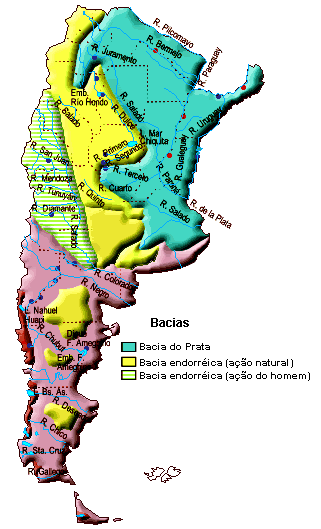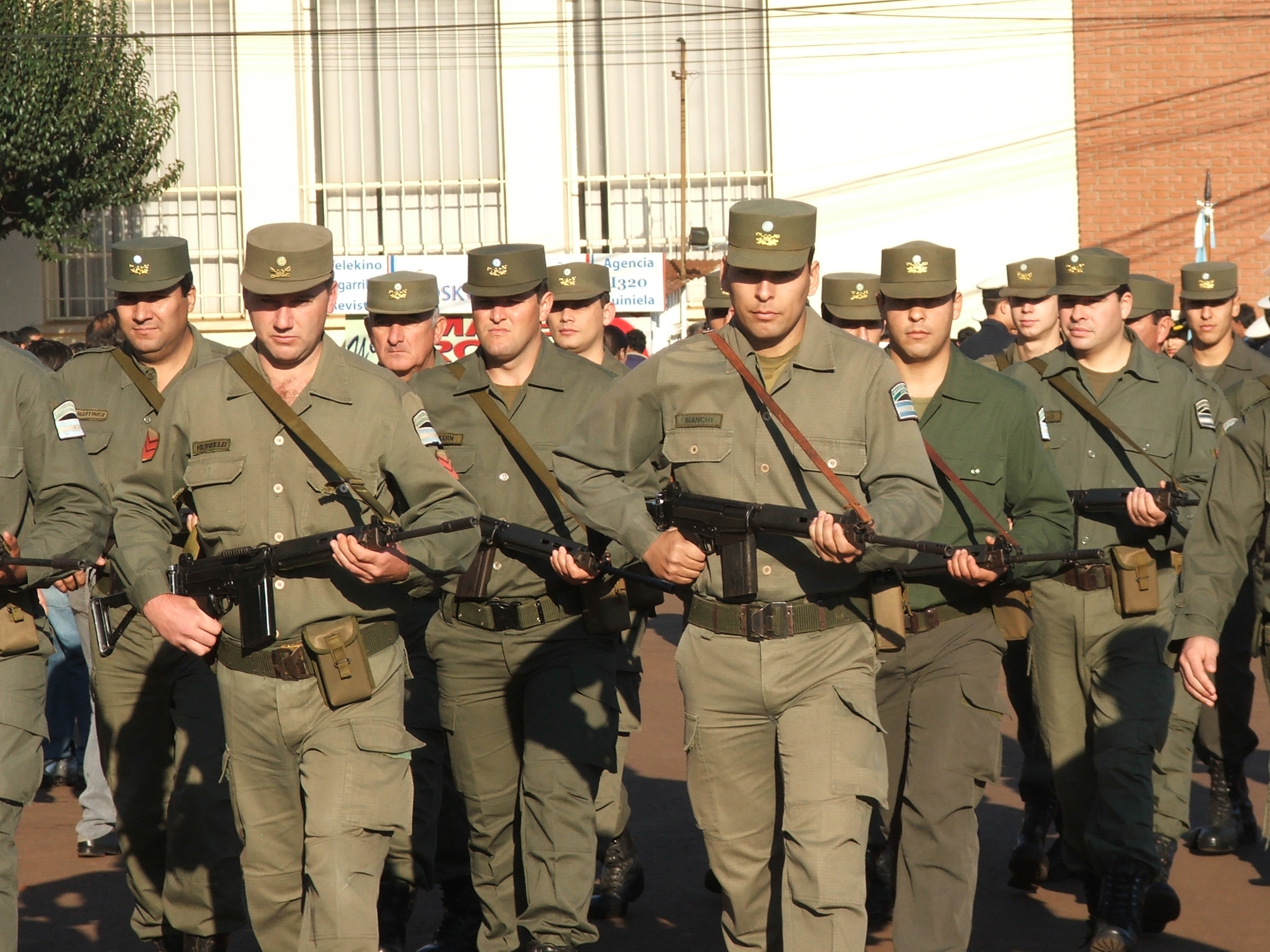|
La Quiaca River
La Quiaca River ( es, Río La Quiaca), also known as Villazón River, is a river of reduced flow on the border between Argentina and Bolivia. It is highly contaminated in its passage through the cities of La Quiaca and Villazón, on its right and left margins, respectively. Between these two cities, across the river, is the Horacio Guzmán International Bridge, which is the only step enabled between the Argentine province of Jujuy and the Potosí Department. This river originates in Toquero and runs from west to east. After passing through La Quiaca, head north towards Bolivia. Its tributaries are the streams of Tafna, the Marsh, Sansana, Yavi and Yavi Chico. It flows into the San Juan del Oro River which in turn joins the Cotagaita River to form the Camblaya River which with the name of Pilaya River ends at the Pilcomayo River. The Argentine National Gendarmerie The Argentine National Gendarmerie ( es, Gendarmería Nacional Argentina, GNA) is the national gendarmerie for ... [...More Info...] [...Related Items...] OR: [Wikipedia] [Google] [Baidu] |
Argentina
Argentina (), officially the Argentine Republic ( es, link=no, República Argentina), is a country in the southern half of South America. Argentina covers an area of , making it the second-largest country in South America after Brazil, the fourth-largest country in the Americas, and the eighth-largest country in the world. It shares the bulk of the Southern Cone with Chile to the west, and is also bordered by Bolivia and Paraguay to the north, Brazil to the northeast, Uruguay and the South Atlantic Ocean to the east, and the Drake Passage to the south. Argentina is a federal state subdivided into twenty-three provinces, and one autonomous city, which is the federal capital and largest city of the nation, Buenos Aires. The provinces and the capital have their own constitutions, but exist under a federal system. Argentina claims sovereignty over the Falkland Islands, South Georgia and the South Sandwich Islands, and a part of Antarctica. The earliest recorded human prese ... [...More Info...] [...Related Items...] OR: [Wikipedia] [Google] [Baidu] |
Pilaya River
Pilcomayo (in Hispanicized spelling) (Quechua Pillkumayu or Pillku Mayu, ''pillku'' red, ''mayu'' river, "red river", Guarani Ysyry Araguay ) is a river in central South America. At long, it is the longest western tributary of the Paraguay River. Its drainage basin is in area, and its mean discharge is . Along its course, the Pilcomayo silts up and splits into two main branches, North and South. After some distance, these branches rejoin to form the Lower Pilcomayo. The Pilcomayo rises in the foothills of the Andes mountain range in the Oruro Department in Bolivia, east of Lake Poopó. The Jach'a Juqhu River is considered the origin of the Pilcomayo. Upstream the Jach'a Juqhu River successively receives the names Aguas Calientes and Kachi Mayu. From the confluence with the Chillawa ''(Chillahua)'', the river is called Pilcomayo. [...More Info...] [...Related Items...] OR: [Wikipedia] [Google] [Baidu] |
Argentina–Bolivia Border
The Argentina–Bolivia border is the international boundary between Argentina and Bolivia. From west to east, the border goes from the Altiplano to extend to the Chaco flat through the tropical environment of the Yungas. Crossing points From east to west there are three main crossing points: * Villazón - La Quiaca ( Horacio Guzmán International Bridge over La Quiaca River) * Bermejo - Aguas Blancas *Yacuíba Yacuiba is a city in southern Bolivia and the capital city of Gran Chaco Province in the Tarija Department. It lies three kilometers from the Argentine border. It has a population of approximately 80,000 and lies above sea level. Yacuiba is on ... - Profesor Salvador Mazza (Pocitos)Robert and Daisy Kunstaetter, Bolivia handbook, footprint handbook, 2008 p.253 References Borders of Argentina Borders of Bolivia International borders {{Bolivia-geo-stub ... [...More Info...] [...Related Items...] OR: [Wikipedia] [Google] [Baidu] |
Rivers Of Potosí Department
A river is a natural flowing watercourse, usually freshwater, flowing towards an ocean, sea, lake or another river. In some cases, a river flows into the ground and becomes dry at the end of its course without reaching another body of water. Small rivers can be referred to using names such as creek, brook, rivulet, and rill. There are no official definitions for the generic term river as applied to geographic features, although in some countries or communities a stream is defined by its size. Many names for small rivers are specific to geographic location; examples are "run" in some parts of the United States, "burn" in Scotland and northeast England, and "beck" in northern England. Sometimes a river is defined as being larger than a creek, but not always: the language is vague. Rivers are part of the water cycle. Water generally collects in a river from precipitation through a drainage basin from surface runoff and other sources such as groundwater recharge, spring ... [...More Info...] [...Related Items...] OR: [Wikipedia] [Google] [Baidu] |
Rivers Of Bolivia
This is a list of rivers in Bolivia. By drainage basin This list is arranged by drainage basin, with respective tributaries indented under each larger stream's name. Rivers longer than are in bold. Rivers that reach the ocean Amazon Basin ** Madeira River *** Abuná River **** Río Negro ***** Pacahuaras River **** Mapiri River **** Rapirrán River **** Chipamanu River **** Xipamanu River *** Beni River including Alto Beni **** Orthon River ***** Tahuamanu River ****** Muymano River ***** Mamuripi River ****** Manuripe River **** Madre de Dios River ***** Sena River ****** San Martín River ****** Manuripi River ***** Heath River ***** Tambopata River **** Ivón River **** Arroyo Verde **** Madidi River ***** Esmeralda River ***** Claro River **** Tuichi River ***** Yariapo River ***** Pelechuco River **** Quiquibey River **** Kaka River ***** Coroico River ****** Camata River ****** Zongo River ***** Mapiri River ****** Challana River ****** Tipuani Riv ... [...More Info...] [...Related Items...] OR: [Wikipedia] [Google] [Baidu] |
Rivers Of Jujuy Province
A river is a natural flowing watercourse, usually freshwater, flowing towards an ocean, sea, lake or another river. In some cases, a river flows into the ground and becomes dry at the end of its course without reaching another body of water. Small rivers can be referred to using names such as creek, brook, rivulet, and rill. There are no official definitions for the generic term river as applied to geographic features, although in some countries or communities a stream is defined by its size. Many names for small rivers are specific to geographic location; examples are "run" in some parts of the United States, " burn" in Scotland and northeast England, and "beck" in northern England. Sometimes a river is defined as being larger than a creek, but not always: the language is vague. Rivers are part of the water cycle. Water generally collects in a river from precipitation through a drainage basin from surface runoff and other sources such as groundwater recharge, springs, ... [...More Info...] [...Related Items...] OR: [Wikipedia] [Google] [Baidu] |
Rivers Of Argentina
This is a list of rivers of Argentina. Longest Rivers By drainage basin This list is arranged by drainage basin, with respective tributaries indented under each larger stream's name. Rivers in the table above are in bold. La Plata Basin * Río de la Plata ** Uruguay River *** Gualeguaychú River *** Mocoretá River *** Miriñay River *** Aguapey River *** Pepiri-Guazu River ** Paraná River *** Arrecifes River *** Gualeguay River *** Nogoyá River *** Arroyo del Medio *** Saladillo Stream *** Ludueña Stream *** Carcarañá River **** Tercero River (Calamuchita River) **** Cuarto River (Saladillo River, Chocancharava River) *** Salado River (Salado del Norte, Juramento River, Pasaje River, Calchaquí River) **** Horcones River ***** Urueña River **** Arenales River **** Rosario River **** Guasamayo River *** San Javier River *** Feliciano River *** Guayquiraró River *** Corriente River *** Paraná Miní River **** Tapenagá River **** Palometa River *** Santa Lucía ... [...More Info...] [...Related Items...] OR: [Wikipedia] [Google] [Baidu] |
Argentine National Gendarmerie
The Argentine National Gendarmerie ( es, Gendarmería Nacional Argentina, GNA) is the national gendarmerie force and corps of border guards of the Argentine Republic. It has a strength of 70,000. The gendarmerie is primarily a frontier guard force but also fulfils other important roles. The force functions from what are today five regional headquarters at Campo de Mayo, Córdoba, Rosario, San Miguel de Tucumán and Bahía Blanca. Personnel and training Non-commissioned personnel of the gendarmerie are all volunteers and receive their training in the force's own comprehensive system of training institutions. Officers graduate after a three-year course at the National Gendarmerie Academy. Both officers and non-commissioned personnel have access to the specialist training establishments of the Army. History The gendarmerie was created in 1938 by the National Congress, and replaced the regiments of the Army which previously fulfilled the gendarmerie's missions. The gendarmerie was ... [...More Info...] [...Related Items...] OR: [Wikipedia] [Google] [Baidu] |
Pilcomayo River
Pilcomayo (in Hispanicized spelling) (Quechua Pillkumayu or Pillku Mayu, ''pillku'' red, ''mayu'' river, "red river", Guarani Ysyry Araguay ) is a river in central South America. At long, it is the longest western tributary of the Paraguay River. Its drainage basin is in area, and its mean discharge is . Along its course, the Pilcomayo silts up and splits into two main branches, North and South. After some distance, these branches rejoin to form the Lower Pilcomayo. The Pilcomayo rises in the foothills of the Andes mountain range in the Oruro Department in Bolivia, east of Lake Poopó. The Jach'a Juqhu River is considered the origin of the Pilcomayo. Upstream the Jach'a Juqhu River successively receives the names Aguas Calientes and Kachi Mayu. From the confluence with the Chillawa ''(Chillahua)'', the river is called Pilcomayo. [...More Info...] [...Related Items...] OR: [Wikipedia] [Google] [Baidu] |
Bolivia
, image_flag = Bandera de Bolivia (Estado).svg , flag_alt = Horizontal tricolor (red, yellow, and green from top to bottom) with the coat of arms of Bolivia in the center , flag_alt2 = 7 × 7 square patchwork with the (top left to bottom right) diagonals forming colored stripes (green, blue, purple, red, orange, yellow, white, green, blue, purple, red, orange, yellow, from top right to bottom left) , other_symbol = , other_symbol_type = Dual flag: , image_coat = Escudo de Bolivia.svg , national_anthem = " National Anthem of Bolivia" , image_map = BOL orthographic.svg , map_width = 220px , alt_map = , image_map2 = , alt_map2 = , map_caption = , capital = La Paz Sucre , largest_city = , official_languages = Spanish , languages_type = Co-official languages , languages ... [...More Info...] [...Related Items...] OR: [Wikipedia] [Google] [Baidu] |
Horacio Guzmán International Bridge
The Horacio Guzmán International Bridge is a bridge that links the city of La Quiaca, Jujuy Province, Argentina Argentina (), officially the Argentine Republic ( es, link=no, República Argentina), is a country in the southern half of South America. Argentina covers an area of , making it the second-largest country in South America after Brazil, th ..., with the city of Villazón, in the Potosí Department of Bolivia, crossing the La Quiaca River. The concrete bridge, 31 meters long and 7.8 meters wide, was opened on July 9, 1960. It is accessed from the south by National Route 9 (Argentina), National Route 9, while from the north it is accessed by Route 14 (Bolivia), Route 14. As the customs of both countries are not integrated, the procedures must be carried out on both banks of the La Quiaca River. A lot of attention should be paid in case of visiting this area with minors, since the customs controls are practically null and it is possible to move from Argentina to ... [...More Info...] [...Related Items...] OR: [Wikipedia] [Google] [Baidu] |



